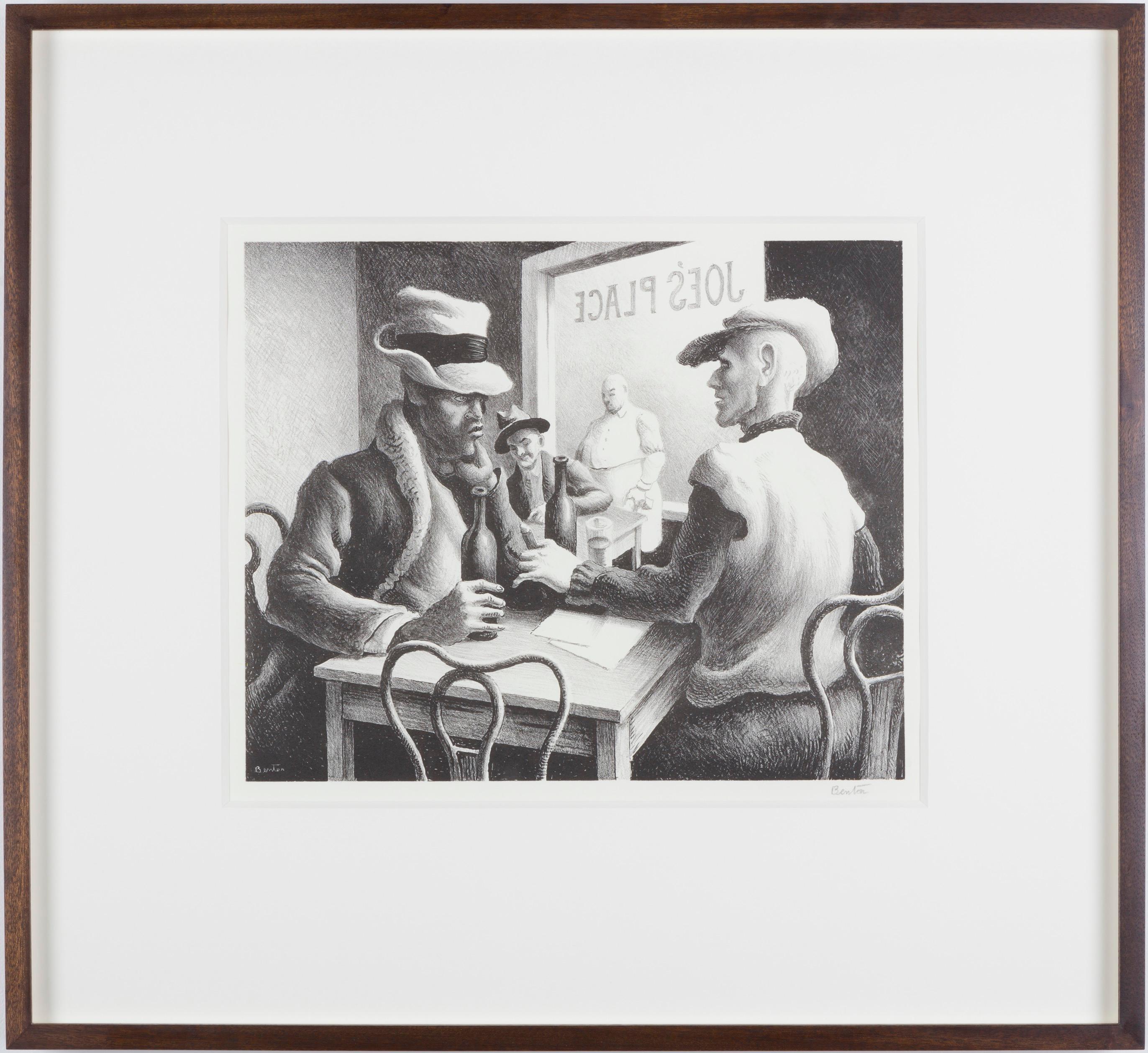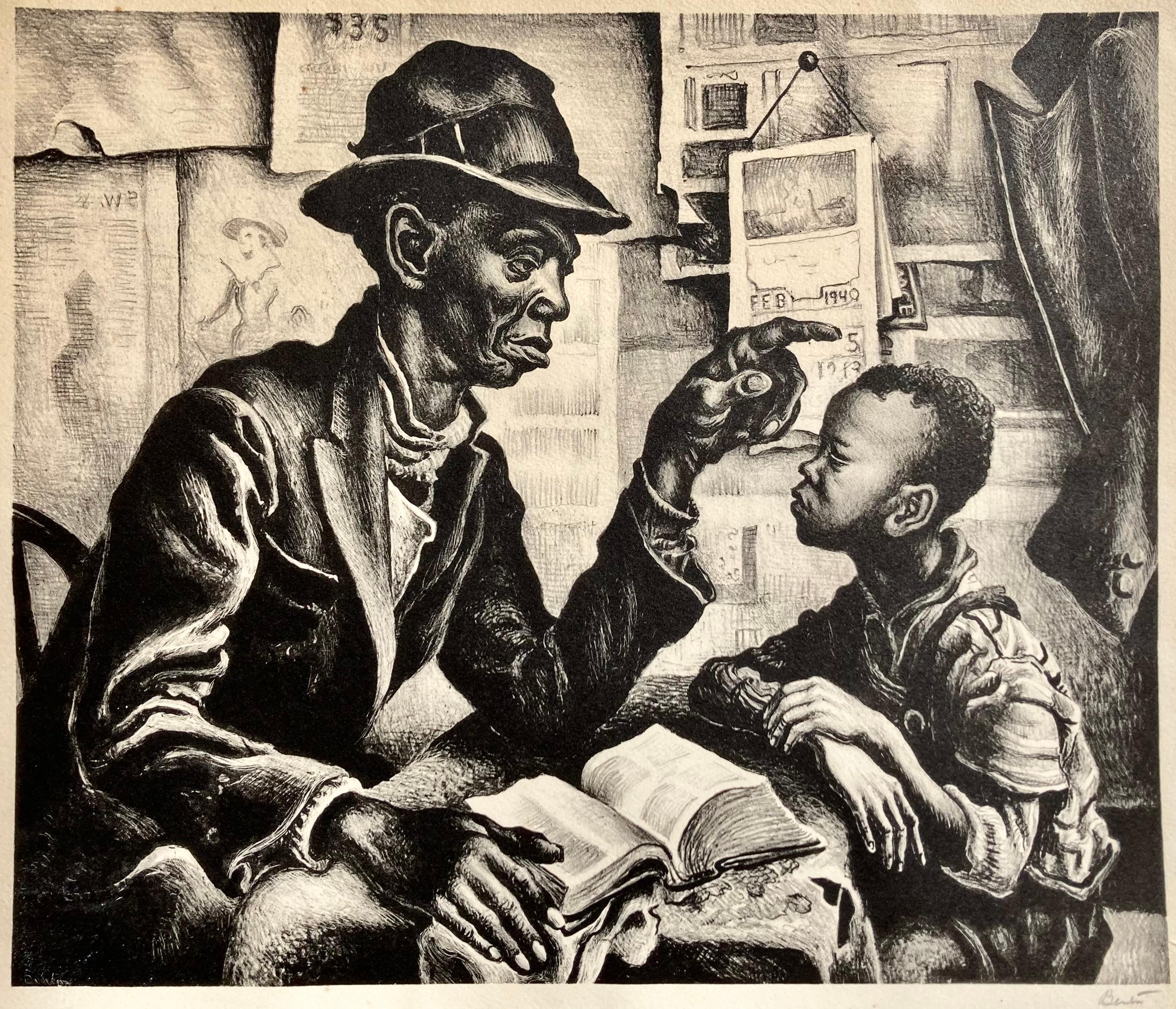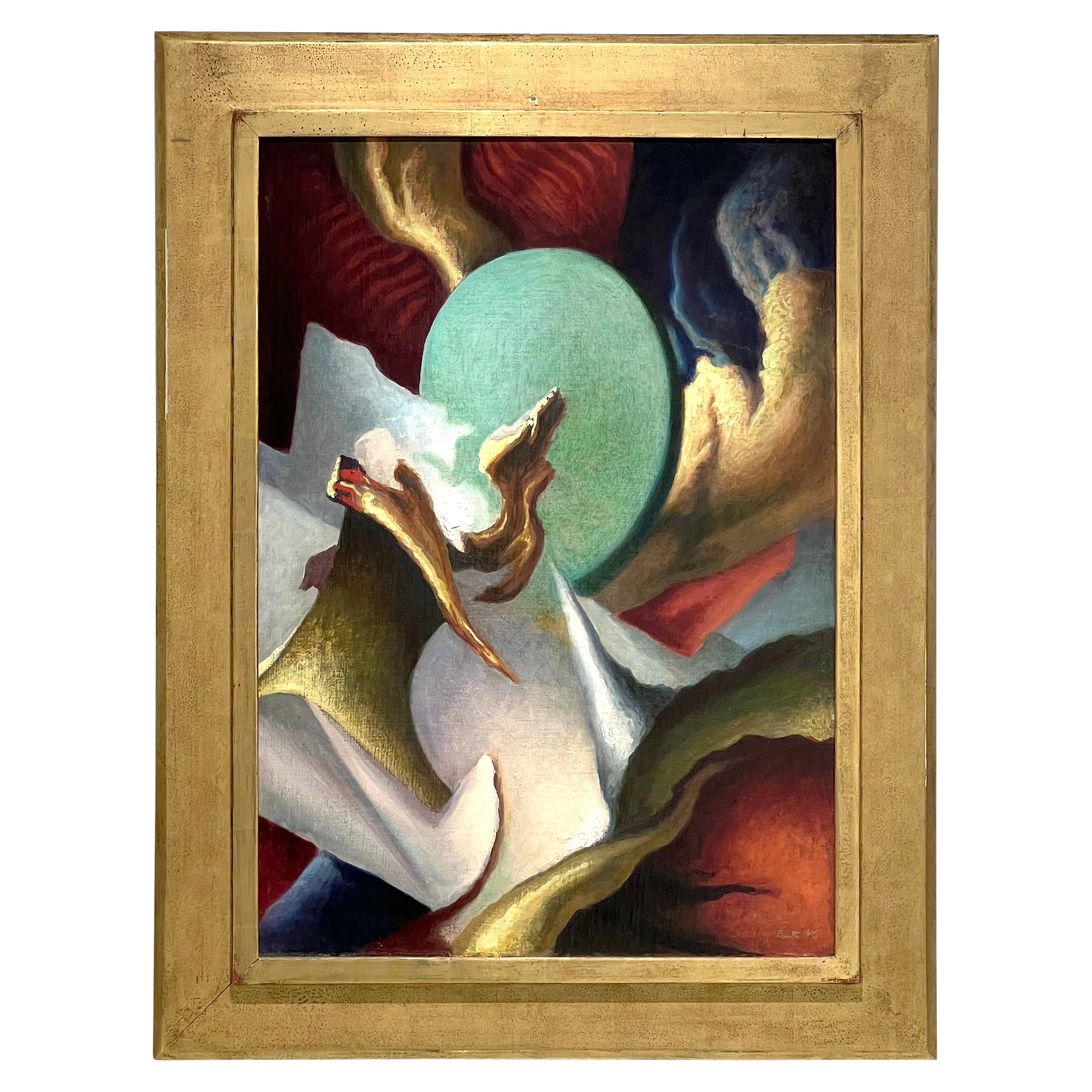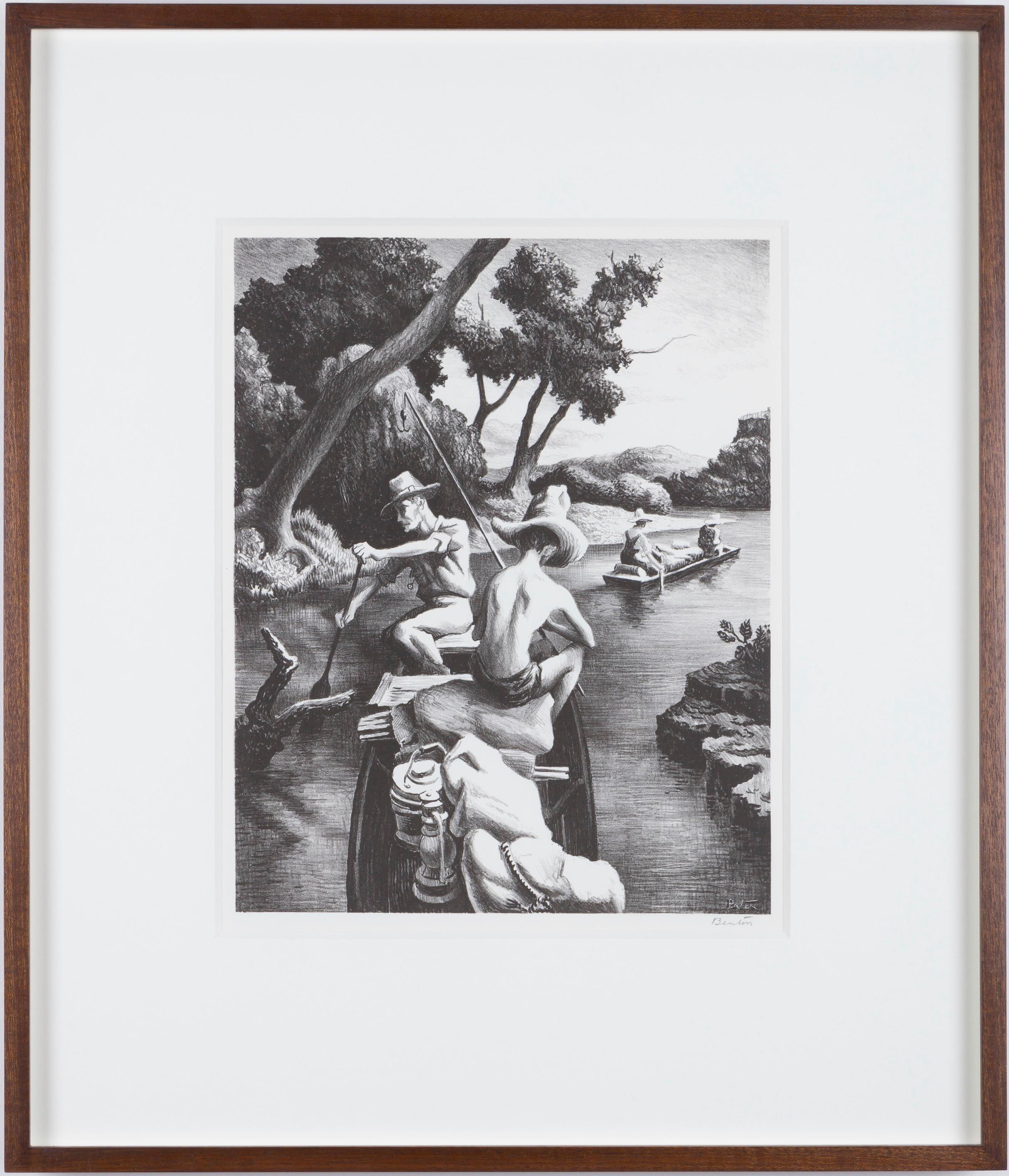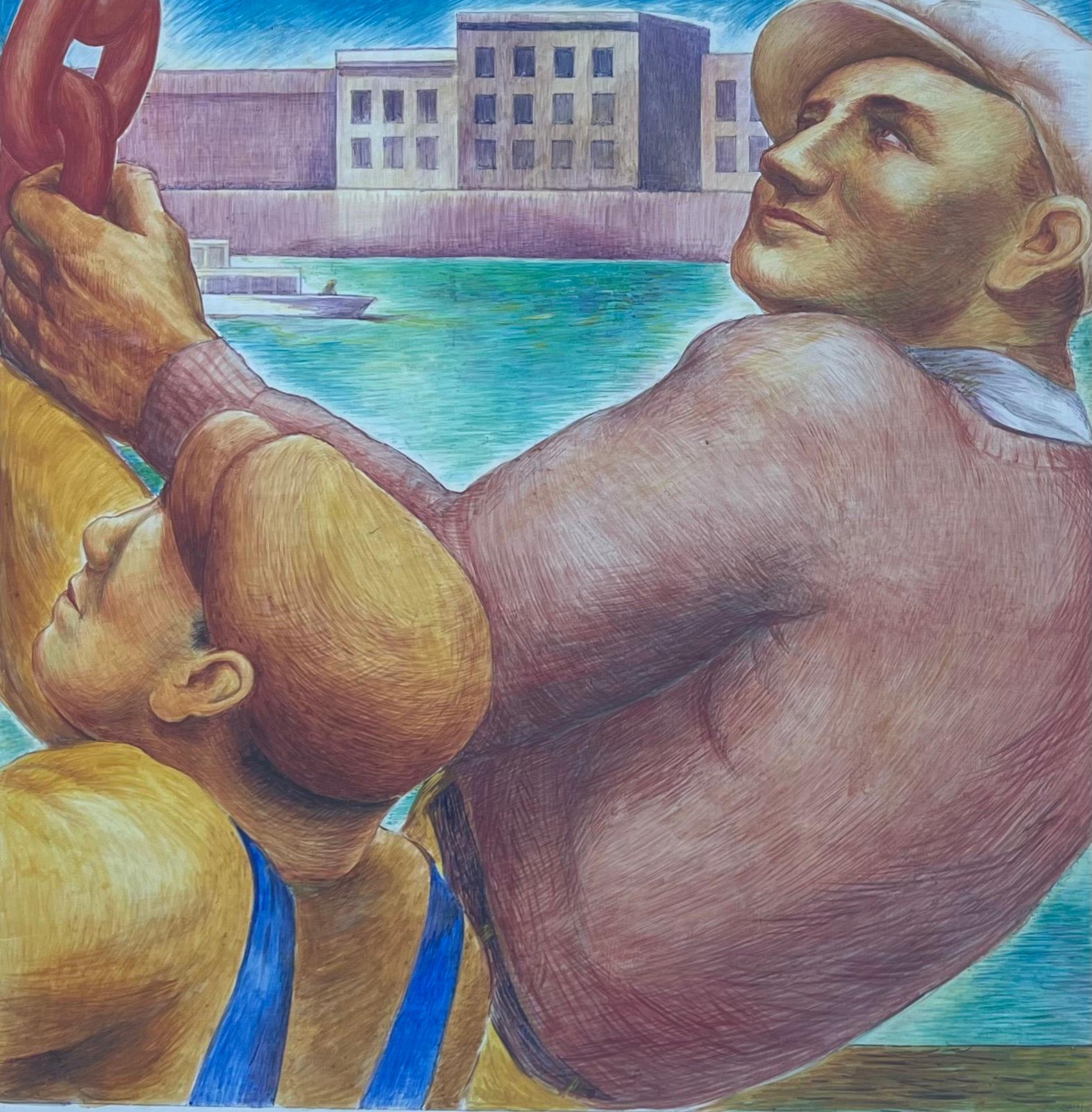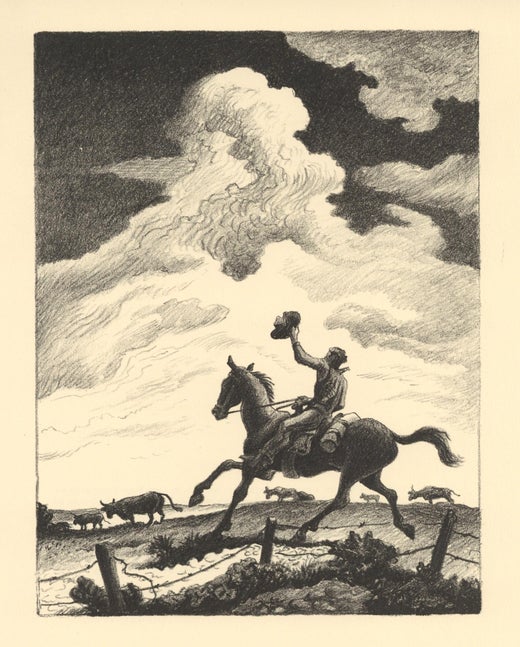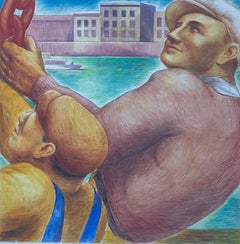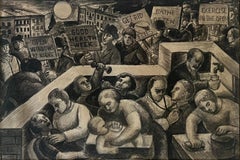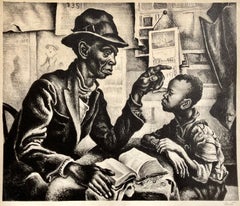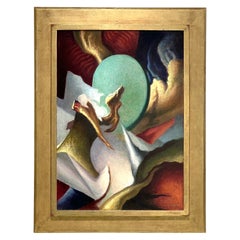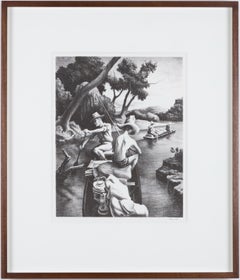Items Similar to Mural Study for "History of Water" American Scene Modernism Social Realism WPA
Video Loading
Want more images or videos?
Request additional images or videos from the seller
1 of 9
Thomas Hart BentonMural Study for "History of Water" American Scene Modernism Social Realism WPA1930
1930
Price Upon Request
Price Upon Request
Price Upon Request
Price Upon Request
Price Upon Request
Price Upon Request
Price Upon Request
Price Upon Request
Price Upon Request
Price Upon Request
About the Item
Mural Study for "History of Water" American Scene Modernism Social Realism WPA
Thomas Hart Benton (American, 1889-1975)
"Water Story" (Study for The History of Water)
Tempera and oil on board, 1930
Unsigned
Board: 20 x 18 inches
Sight: 19 x 15 inches
Framed 28 x 24 inches
Footnotes:
Provenance
Donald B. Stegner, New Jersey.
By descent.
A private collection, St. Petersburg, Florida, 1995.
A private collection, Zurich, Switzerland, 2016.
A private collection, Canada.
The painting is a study for Thomas Hart Benton's 1930 mural "The History of Water," which was commissioned for a Washington, D.C., drugstore. "Water Story" also relates to one of the artist's most renowned murals, "America Today," executed for the dining room of the New School for Social Research in New York in 1930/31.
In a deal with the institution's director, Alvin Johnson, Benton agreed to create "America Today" without compensation. Realizing that the artist was financially short, Johnson arranged for a paid commission with a drugstore on 14th Street in Washington, D.C.
Additionally, many of the figures depicted in "Water Story" relate to Benton's next commission, "The Arts of Life in America," which was created for the Whitney Museum of American Art in 1932.
This work will be included in the forthcoming catalogue raisonné being prepared by the Thomas Hart Benton Catalogue Raisonné Foundation.
The History of Water
Written by Dr. Henry Adams, author of “Thomas Hart Benton: An American Original.”
Thomas Hart Benton established his reputation in the 1930s with five mural projects which changed the face of American art and provided the principle artistic model for the WPA mural program. They are generally considered the most important mural projects ever executed in the United States. Four of these projects, have an extensive bibliography and have been widely reproduced in monographs and textbooks on American art. The fifth, "The History of Water," disappeared from sight soon after it was executed, since when the drugstore in Washington D.C. for which it was painted went out of business, it was removed from the wall and placed in the basement, where it sat unnoticed for nearly half a century. It was rediscovered in 1985, when someone noticed that it was signed Benton in black paint at the lower right. After being verified as a long-missing work by Thomas Hart Benton, it was put up for auction at Sotheby’s (sale of December 6, 1984, lot no. 219).
Since Benton’s murals of the 1930s, the group of works most closely related to "The History of Water," have almost all been moved from their original locations I think it’s helpful to list them here.
"The Arts of Life in America," executed for the Whitney Museum of American Art in 1932, currently owned by The New Britain Museum of Art, New Britain, Connecticut.
"A Social History of Indiana," executed for the Indiana Pavilion at the Century of Progress Exposition in Chicago in 1933, currently owned by the University of Indiana, and on view in the History Building and Theater Building.
"A Social History of Missouri," executed for the Missouri State Capitol in Jefferson City in 1935, and still on view there, the only Benton mural of the 1930s which is still in its original location.
While admittedly more modest in scale than the other four murals, several things make "The History of Water" quite notable both historically and artistically: it comes from Benton’s best period, it is exactly contemporary with Benton’s most important mural, "America Today," and relates very closely to it..
The commission for "The History of Water" came about because of Benton’s creation of his first and arguably his great mural, "America Today" for the New School for Social Research in New York, a center of progressive and reform-minded educators (including several figures who had recently been fired from Columbia University, such as Marxist historian Charles Beard).
For nearly a decade Benton had been producing a series of large mural-like history paintings, The American Historical Epic, in the hope that some architect would provide him a wall to paint. In 1930, when Benton was represented by the Delphic Galleries, Alma Reed, who managed the gallery, arranged a commission for her lover Jose Clement Orozco to execute a mural for the dining room of The New School for Social Research, which was being built to design by the modernist Joseph Urban. Outraged that a Mexican should be favored over an American, Benton’s friend Ralph Pierson went to the director of the New School, Alvin Johnson, and arranged a commission for Benton as well – a mural for the building’s board room.
Since there was no budget for such a painting, Benton agreed to execute the project for no pay except for the cost of the materials. As he memorably told Johnson (referring to his egg tempera medium): “I’ll do the mural if you’ll give me the eggs.”
Aware that Benton was hard-up, and obviously embarrassed that he was being financially exploited, Johnson made restitution by arranging another commission for Benton for which he was actually reimbursed: a painting on the theme of "The History of Water" for a drugstore in Washington D.C. It’s unclear where Benton executed the painting, but since it’s too large to have fit in his apartment most likely he either executed it in situ in Washington D.C., or in the very loft-space in New York that Alvin Johnson provided to him for the creation of "America Today."
My belief is that "The History of Water" is almost exactly contemporary with Benton’s last (and best) two panels from the "America Today" mural, City Activities with Subway and City Activities with Dance Hall. Many of the motifs in "The History of Water" are extremely similar to the ones in these two panels and it’s likely that they were based on alternative sketches that Benton had made of the same models. In particular, the background of The History of Water, the soda-fountain scene is extremely similar to America Today, so much so that it almost might be considered an additional scene of the mural.
For example, the woman with a hat and high heels who is sitting on a barstool in "The History of Water" also appears in "City Activities with Subway." She is the well-known burlesque performer Peggy Reynolds, who appears in the subway scene of America Today, where she is being ogled by Max Eastman. In fact, Benton probably used exactly the same drawing for both murals (this drawing is now in the collection of Equitable Life Assurance, which also owns the "America Today" mural).
To prevent this reuse from becoming too obvious, he reversed the direction of the head and changed the color of her hat (from red to gold) and of her dress (from gold to blue).
Most of the other figures are extremely close to those in a similar soda fountain scene on the right hand side of "City Activities with Dance Hall." From Benton’s unpublished memoir, "The Intimate Story," we know that the soda jerk in "America Today" was his friend Leo Huberman, who wrote a Marxist history of the United States, published in 1933, We, the People, which Benton illustrated. The figure in "The History of Water" seems to be the same person, with the same features and hairline, although drawn a little more loosely and equipped with a hat. I think it’s likely that the man and woman seated at the counter were also based on sketches that Benton made of the figures sitting at the counter in "America Today," although he deliberately jiggled their likeness a little to make the resemblance not too noticeable.
The woman in a red dress applying make-up on the left side of "The History of Water" is probably the same women who appears on the left side of "City Activities with Dancer," where she is dancing with an elderly man. She has the same figure, the same red dress, the same Marceled hair style as the woman in the "America Today" mural. What is more, the woman in a blue dress behind her in "History of Water" may be the same model as the woman in a blue dress who appears behind the dancer in "America Today". Certainly her role in the composition is very similar.
As one studies the two paintings more closely, one can pick out other interesting visual parallels. For example, the metal coffee cylinders at the upper right of The History of Water are quite reminiscent in form of the bootleg liquor distillery that appears at the lower left in "City Activities with Dance Hall."
Several figures in "The History of Water" also bear a general relationship with figures in Benton’s next major mural project, "The Arts of Life in America, 1932," for the Whitney Museum of American Art. Thus, for example, the figure with a cap at the end of the counter is similar to the man sipping coffee in the section of the Whitney mural that Benton titled “None Shall Go Hungry.”
The foreground of "The History of Water" does not closely relate to "America Today." Probably Benton made new drawings for this section, although the figures resemble figures found in other murals. Thus for example, the kneeling Indian resembles Indian figures found in Benton’s "American Historical Epic" of the 1920s, as well as Indians found in the opening scenes of his mural of "A Social History of Indiana." The little boy pumping water at the lower left is probably Benton’s son, Thomas Piacenza Benton, who was included a few years later in Benton’s "Arts of Life in America" mural, where he is reading comic books with Benton’s nephew Roger Small (the son of Benton’s younger sister, Mildred). I suspect that the little girl may be one of Benton’s nieces but can’t provide a specific identification.
The authenticity of "The History of Water" is confirmed by the fact that there are many studies by Benton for the composition, including drawings preserved in the Benton Trust.
A sketch for the girl at the soda fountain is in the Benton Trust and is reproduced in a book by Karal Ann Marling, "Tom Benton and His Drawings" (University of Missouri Press, Columbia, Missouri, 1985, reproduced on page 128; discussed by Marling on page 125). The Benton Trust also holds a drawing of a coffee urn that probably provided guidance for this mural (Marling, page 29).
Several factors make "The History of Water" notable both historically and artistically: it comes from what is generally considered to be Benton’s best period; it relates closely to Benton’s most famous mural, "America Today."
- Creator:Thomas Hart Benton (1889-1975, American)
- Creation Year:1930
- Dimensions:Height: 28 in (71.12 cm)Width: 24 in (60.96 cm)
- Medium:
- Movement & Style:
- Period:
- Condition:
- Gallery Location:New York, NY
- Reference Number:1stDibs: LU1156215718732
Thomas Hart Benton
Thomas Hart Benton was born in Neosho, Missouri on April 15, 1889. Even as a boy, he was no stranger to the "art of the deal" or to the smoke-filled rooms in which such deals were often consummated. His grandfather had been Missouri's first United States Senator and served in Washington for thirty years. His father, Maecenas Benton, was United States Attorney for the Western District of Missouri under Cleveland and served in the United States House of Representatives during the McKinley and Theodore Roosevelt administrations. Benton's brother, Nat, was prosecutor for Greene County, Missouri, during the 1930s. As soon as he could walk, Benton traveled with his father on political tours. There he learned the arts of chewing and smoking, and while the men were involved in their heated discussions, Benton delighted in finding new cream colored wallpaper on the staircase wall, at the age of six or seven, and drew in charcoal his first mural, a long multi-car freight train. As soon as he was eighteen, even though his father wanted him to study law, Benton left for Chicago where he studied at the Art Institute during the years 1907 and 1908. He continued his studies in Paris, where he learned delicious wickedness, aesthetic and otherwise. Once back home, he became the leader of the Regionalist School, the most theatrical and gifted of the 1930s muralists and as Harry Truman described him,"the best damned painter in America." Detractors said that Benton was "a fascist, a communist, a racist and a bigot"; the ingenious structure, powerful use of modeling and scale and the high-colored humanity of the murals and easel paintings are retort enough. He was a dark, active dynamo, only 5 ft., 3 1/2 in. tall. He was outspoken, open, charmingly profane; he had a great mane of hair and a face the texture of oak bark. He wore rumpled corduroy and flannel, and walked with the unsteady swagger of a sailor just ashore. He poured a salwart drink, chewed on small black cigars and spat in the fire. Benton was once described as the "churlish dean of regionalist art." If you listened to a variety of art authorities, you would find them equally divided between Harry Truman's assessment of Benton as "the best damned painter in America" and Hilton Kramer who proclaimed Benton "a failed artist." The East Coast art establishment tended to regard Benton as memorable for one reason only: he was the teacher of Jackson Pollock. Benton was married in 1922 to Rita, a gregarious Italian lady, and they had a daughter and a son. At the height of his fame in the 1940s, Benton bungled the buy-out he was offered by Walt Disney and went his own way, completing his last mural in 1975 in acrylics the year of his death. He died in 1975.
About the Seller
5.0
Gold Seller
Premium sellers maintaining a 4.3+ rating and 24-hour response times
Established in 2008
1stDibs seller since 2019
195 sales on 1stDibs
Typical response time: <1 hour
- ShippingRetrieving quote...Shipping from: Pawling, NY
- Return Policy
Authenticity Guarantee
In the unlikely event there’s an issue with an item’s authenticity, contact us within 1 year for a full refund. DetailsMoney-Back Guarantee
If your item is not as described, is damaged in transit, or does not arrive, contact us within 7 days for a full refund. Details24-Hour Cancellation
You have a 24-hour grace period in which to reconsider your purchase, with no questions asked.Vetted Professional Sellers
Our world-class sellers must adhere to strict standards for service and quality, maintaining the integrity of our listings.Price-Match Guarantee
If you find that a seller listed the same item for a lower price elsewhere, we’ll match it.Trusted Global Delivery
Our best-in-class carrier network provides specialized shipping options worldwide, including custom delivery.More From This Seller
View AllWPA Mural Study American Scene Social Realism Mid 20th Century Modern Workers
By Seymour Fogel
Located in New York, NY
WPA Mural Study American Scene Social Realism Mid 20th Century Modern Workers
Seymour Fogel (1911-1984)
Mural Study, untitled
11 x 49 1/4 inches (sight)
Tempera on board
Provenance:...
Category
1930s American Modern Figurative Paintings
Materials
Egg Tempera, Board
St, Louis River Mural Study American Scene Social Realism Mid 20th Century WPA
By Jo Cain
Located in New York, NY
St, Louis River Mural Study American Scene Social Realism Mid 20th Century WPA
Jo Cain (1904-2003)
The Drama of the St. Louis Great River
23 1/4 x 25 ½ inches
Gouache on board c. 19...
Category
1930s American Realist Figurative Paintings
Materials
Gouache, Board
"Good Health Week" American Scene Modern Social Realism Mid 20th Century WPA Era
By Jo Cain
Located in New York, NY
"Good Health Week" American Scene Modern Social Realism Mid- 20th Century WPA Era
Jo Cain (1904 – 2003)
Good Health Week – b/w
10 ½ x 15 1/2 inches
I...
Category
1930s American Realist Figurative Drawings and Watercolors
Materials
Paper, Ink
WPA Post Office Mural Study American Scene Regionalism Social Realism Modern Art
By Louise Ronnebeck
Located in New York, NY
WPA Post Office Mural Study American Scene Regionalism Social Realism Modern Art
Louise Emerson Ronnebeck (1901 - 1980)
Oil Riggers, Mural Study
Image: 6 1/2 x 37 inches
Watercolor ...
Category
1930s American Modern Figurative Drawings and Watercolors
Materials
Watercolor, Cardboard, Paper
Post Office WPA Mural Study American Scene Social Realism Modern 20th Century
By Carlos Lopez
Located in New York, NY
Post Office WPA Mural Study American Scene Social Realism Modern 20th Century
Carlos Lopez (1910-1953)
"Bounty" WPA Mural Study for Michigan Post Office
19 ½ x 22 ½ inches
Oil on B...
Category
1940s American Realist Figurative Paintings
Materials
Oil, Board
"Good Health Week" WPA American Scene Mid 20th Century Modern Social Realism
By Jo Cain
Located in New York, NY
"Good Health Week" WPA American Scene Mid 20th Century Modern Social Realism
Jo Cain (1904 – 2003)
Good Health Week
10 ½ x 15 1/2 inches
Oil on pape...
Category
1940s American Realist Figurative Drawings and Watercolors
Materials
Paper, Oil
You May Also Like
Discussion
By Thomas Hart Benton
Located in London, GB
In this charming regionalist lithograph, Benton captures a classic Midwestern American scene: two men talking, drinking, and smoking together in a bar. Titled 'Discussion', the artwo...
Category
1930s American Modern Figurative Prints
Materials
Lithograph
INSTRUCTION
By Thomas Hart Benton
Located in Santa Monica, CA
THOMAS HART BENTON (1889-1975)
INSTRUCTION 1940 (Fath 41)
Lithograph, signed edition of 250 as published by Associated American Artists.
10 ¼” x 12 ¼”. Full margins, deckle edges....
Category
1940s American Realist Figurative Prints
Materials
Lithograph
"FANTASY" Oil on Canvas by Thomas Hart Benton
By Thomas Hart Benton
Located in New York, NY
"FANTASY" by Thomas Hart Benton. Oil on canvas laid on wood with a gorgeous gold gilded frame. Price upon request.
Category
Vintage 1940s American Mid-Century Modern Paintings
Materials
Canvas, Paint
Down the River
By Thomas Hart Benton
Located in London, GB
In this sentimental work from 1939, Benton expresses his admiration for the rural lifestyle of the Midwest. He highlights the connection between man and the land by depicting two fig...
Category
1930s American Modern Figurative Prints
Materials
Lithograph
Copy of Thomas Har Benton's "Building of Railroad" Painting
Located in Queens, NY
Copy of a painting by Thomas Hart Benton "Building of Railroad"
Category
Late 20th Century American Art Deco Paintings
Materials
Paint
"Loading the Wagon", Important Regional Scene Ptg, Thomas Hart Benton Colleague
Located in Philadelphia, PA
This classic example of American Scene painting, depicting a group of four laborers loading the harvest onto a wagon amidst the fields, has the energy and dynamic of Thomas Hart Bent...
Category
Vintage 1930s American Art Deco Paintings
Materials
Paint
Read More
Al Hirschfeld’s Take on Judy Garland Stands out among His Many Love Letters to Broadway
The revered artist created delightful caricatures of stage and screen performers for more than 75 years. This one is a prime example.
Ludwig Bemelmans Captures the Thrilling Sight of Coney Island at Night
The ‘Madeline’ creator and Carlyle Hotel legend was in a New York state of mind in the 1940s when he produced this exuberant and rare oil painting.
More Ways To Browse
Paintings Of Eggs
Drawing Of Woman In Hat
St Petersburg Florida
Vintage Burlesque
Hart Oil Paintings
Red And Gold Dress
Water Scenes Oil Paintings
Soda Fountain
Modern Paintings Of Water
Thomas Hart Benton Original
Babatunde Adeogun
Bartosz Kolata
Beach Painting People
Christopher Street
Crucifixion Oil Paintings
Cyclist Painting
Frans Francken
Gay Mens Paintings
